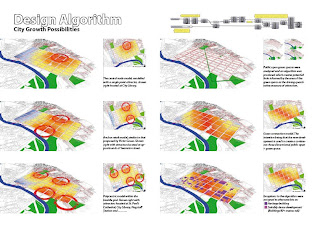 SynapseCity explores a system approach to design, taking the dynamic and adaptive synaptic system of information exchange, reinforcement and connection generation into an urban implementation. The system attempts to resolve problems regarding densification of the existing city and housing within it both city-dweller and suburbanite.
SynapseCity explores a system approach to design, taking the dynamic and adaptive synaptic system of information exchange, reinforcement and connection generation into an urban implementation. The system attempts to resolve problems regarding densification of the existing city and housing within it both city-dweller and suburbanite.
Friday, December 17, 2010
SynapseCity - Nov 2010
 SynapseCity explores a system approach to design, taking the dynamic and adaptive synaptic system of information exchange, reinforcement and connection generation into an urban implementation. The system attempts to resolve problems regarding densification of the existing city and housing within it both city-dweller and suburbanite.
SynapseCity explores a system approach to design, taking the dynamic and adaptive synaptic system of information exchange, reinforcement and connection generation into an urban implementation. The system attempts to resolve problems regarding densification of the existing city and housing within it both city-dweller and suburbanite.
Design Algorithm_City Growth Possibilities
The Hub, Centre of New Culture - Nov 2009
ImpellerLogic - StudioHatzellis June 2009
ImpellerLogic

VIDEO- http://www.youtube.com/watch?v=a7Kpc2ujvQY
AGENDA
to create a system where human trajectory paths inform and effect the building at scales from the form to the detail while instilling modern pedagogical methods.
MATERIAL SYSTEM

video- http://www.youtube.com/watch?v=TwDsfZXuWHM
The base material system we chose was a fractal composition, a mesh composed of self-similar scaling triangular surfaces which folded and stretched when under the unfluence. Various digital modelling processes where used to control deformation, variables of which were informed directly by data collected onsite and diagrams involving program volumetric requirements, adjacencies and connections and time based fluctuations of use.
LAYOUT AND ADJACENCIES


As focus was placed on the connections, we blurred the idea of the conventional classroom. By creating ramps and stairs where digital projections convey the transition between disciplines, to provoke responses, and which can promote spontaneous events while allowing the learning process and absoprtion of ideas/information to continue.
PHYSICAL MODEL

By using pepakura, we were able to unfold our digital model. this was then fabricated using a digital card cutter. However the first model did not have enough structure to resist the forces of gravity, so a load bearing facade was introduced as a secondary structure.
DOCUMENTATION

We then continued the design process, producing documentation which allwed for further resolution. Plans, sections and elevations.
DYNAMIC FACADE

Video- http:/www.youtube.com/watch?v=gJ4Wu327xwo
Towards the end of the design process we began to develope a dynamice facade system which responded kinetically to human porximity. This furthered out agenda of movement and the response of the built form to it, also as a way of conveying that movement to the external viewers.
DIAGRAM TO FURNITURE


From diagramming the volumetric requirements of the learning spaces we ascertained various ergonomic and working surfaces required to allow for various forms of interaction. Areas for various sizes of interaction within open learning spaces were then differentiated by modular, double functioning furniture and deformation of floor plates.
FINAL RENDER FROM EXHIBITION STREET

ImpellerLogic Learning Academy
80 Collins Street, Nauru House Forecourt.

VIDEO- http://www.youtube.com/watch?v=a7Kpc2ujvQY
AGENDA
to create a system where human trajectory paths inform and effect the building at scales from the form to the detail while instilling modern pedagogical methods.
MATERIAL SYSTEM

video- http://www.youtube.com/watch?v=TwDsfZXuWHM
The base material system we chose was a fractal composition, a mesh composed of self-similar scaling triangular surfaces which folded and stretched when under the unfluence. Various digital modelling processes where used to control deformation, variables of which were informed directly by data collected onsite and diagrams involving program volumetric requirements, adjacencies and connections and time based fluctuations of use.
LAYOUT AND ADJACENCIES

VIDEO- http://www.youtube.com/watch?v=AFDANnPGZTM
By examining the bried and considering modern pedagogical methods we created an early diagram which showed important connections between the learning enviroment. From this diagram we were able to replicate relationships in digital space, and create several spatial iterations where the strength of the connections informed the relative adjacencies. From this process we selected the most appropriate outcome.
LEARNING RAMP
As focus was placed on the connections, we blurred the idea of the conventional classroom. By creating ramps and stairs where digital projections convey the transition between disciplines, to provoke responses, and which can promote spontaneous events while allowing the learning process and absoprtion of ideas/information to continue.
PHYSICAL MODEL

By using pepakura, we were able to unfold our digital model. this was then fabricated using a digital card cutter. However the first model did not have enough structure to resist the forces of gravity, so a load bearing facade was introduced as a secondary structure.
DOCUMENTATION

We then continued the design process, producing documentation which allwed for further resolution. Plans, sections and elevations.
DYNAMIC FACADE

Video- http:/www.youtube.com/watch?v=gJ4Wu327xwo
Towards the end of the design process we began to develope a dynamice facade system which responded kinetically to human porximity. This furthered out agenda of movement and the response of the built form to it, also as a way of conveying that movement to the external viewers.
DIAGRAM TO FURNITURE


From diagramming the volumetric requirements of the learning spaces we ascertained various ergonomic and working surfaces required to allow for various forms of interaction. Areas for various sizes of interaction within open learning spaces were then differentiated by modular, double functioning furniture and deformation of floor plates.
FINAL RENDER FROM EXHIBITION STREET

ImpellerLogic Learning Academy
80 Collins Street, Nauru House Forecourt.
Subscribe to:
Comments (Atom)












